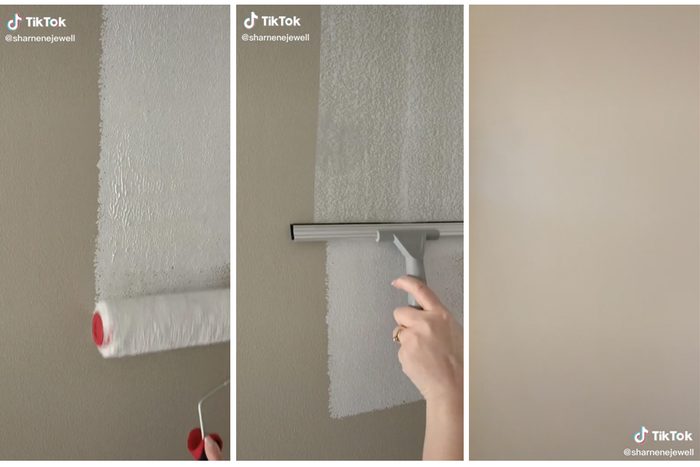Will This TikTok Painting Hack Make Your Walls Smoother?

Annoyed by paint rollers leaving texture on your walls? We tested a trending internet hack that claims to solve this problem.
Our editors and experts handpick every product we feature. We may earn a commission from your purchases.
If you’ve done much interior painting, you probably agree it’s harder than it looks. One reason is the inherent difficulty of achieving a smooth wall surface.
Modern paint rollers make the job much faster and easier, but there’s one problem: Many rollers are made of fibrous wool or a synthetic version of wool. This leaves the painted surface even but somewhat textured. Some homeowners find it ugly, preferring perfectly smooth, shiny walls. Trouble is, with wool or wool-like rollers, there’s no way to avoid it.
That’s where this internet hack comes in. In a few seconds, the video shows a way to smooth walls after rolling on paint.
On This Page
How It Works
@sharnenejewell Smoooth! 😎 No sanding or plastering! Roller stipple gone 🙌 #decorating #hacks #diyonabudget #paintinghack
Traditional wall painting involves priming, then rolling on paint as smoothly and evenly as possible. This hack suggests that besides a prepped and primed wall, roller and paint tray, you should have a rubber-edged squeegee at the ready.
Typically used for cleaning windows and drying off shower walls, squeegees guide a medium-soft, straight rubber blade over the surface. The idea is to apply paint with the roller, and then gently pass the squeegee over the wet paint, smoothing it and removing the texturing.
Results
This hack didn’t work particularly well for me. The biggest problem was paint removal.
I began by painting a section of wall with a standard roller. Trouble was, when I passed the squeegee over the wet paint, it removed almost all of it. Sure, the wall was smoother, but only because it had almost no paint on it.
Unwilling to call it quits too soon, I experimented with different pressures, angles and even squeegee blades. For the most part, the results were the same. I found it difficult to move the squeegee across the wall gently enough to smooth out the roller texturing without removing substantial amounts of paint.
I also found the squeegee blade acted like a miniature dam, forming ridges of wet paint which required more roller work to smooth out. That undid any good I’d done with the squeegee.
Eventually, after considerable practice and experimentation, I found the optimal level of squeegee pressure to smooth most of the roller texturing while removing minimal paint. Problem was, the finished result still didn’t look great. On closer inspection, I found visible lines in the paint, and some areas were thicker than others.
Bottom line: I didn’t find this hack worthwhile. I have considerable painting experience, but found this technique took quite a lot of trial and error to implement correctly. Ultimately, it wasn’t worth the extra effort or time involved.
Better Options
If you’re concerned about paint rollers leaving texture on your walls, here are a few options I think are much more worthwhile than this hack:
- Use a foam roller: Not all paint rollers are made of wool-like material. Some are polyurethane foam, which leaves considerably less texturing behind than wool.
- Try a latex paint additive: Paint additives slow the drying process and help decrease roller texturing. They do it by giving the paint longer to “flow out” after it has been applied to your walls. Longer dry time and more flow mean less texture and more uniform surfaces.
- Ignore it: As a guy who’s applied many coats of paint to many walls, I can assure you roller texturing really isn’t a big deal. Once the paint’s dry, it’s hardly noticeable. For all intents and purposes, roller-painted walls are perfectly smooth, without any extra work. You’d have to look carefully with a flashlight to detect the texturing. Besides, roller-textured paint has its advantages. Mainly it hides imperfections. No drywall taping and mudding job is perfect, and slightly textured paint can help hide some of these natural irregularities.



